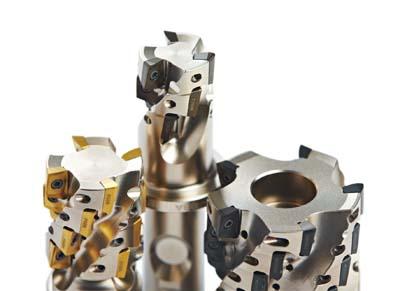
To continue the success of its Turbo 10 series of square shoulder milling cutters and provide manufacturers with increased machining flexibility in tough materials, Seco Tools is expanding the product line to include more inserts with new geometries and radii as well as helical cutters.
The insert range expansion includes both direct pressed and ground insert alternatives with corner radii ranging from 0.016" to 0.122" (0.4mm to 3.1mm). The new geometries for the ground insert range provide increased performance in materials with unique challenges, including aluminum, stainless steels, titanium alloys and other difficult-to-machine alloys.
The new helical cutters are ideal for helical shoulder milling applications that require process stability, flexibility and high precision. The cutters are available in diameters ranging from 0.75" to 2" (20mm to 54mm) and include Weldon, Seco Weldon, Combimaster heads, Seco-Capto and Arbor mounting options.
All Turbo 10 cutters include precision milled pocket seats that improve run-out, stability and tool life by providing optimal contact between the tool body and insert. Integrated through-coolant channels support high productivity and promote excellent chip evacuation. Because of their high levels of flexibility, Turbo 10 cutters work in slotting, shouldering, ramping, facing, pocketing, plunging and turn milling applications.
Contact Details
Related Glossary Terms
- alloys
alloys
Substances having metallic properties and being composed of two or more chemical elements of which at least one is a metal.
- arbor
arbor
Shaft used for rotary support in machining applications. In grinding, the spindle for mounting the wheel; in milling and other cutting operations, the shaft for mounting the cutter.
- gang cutting ( milling)
gang cutting ( milling)
Machining with several cutters mounted on a single arbor, generally for simultaneous cutting.
- milling
milling
Machining operation in which metal or other material is removed by applying power to a rotating cutter. In vertical milling, the cutting tool is mounted vertically on the spindle. In horizontal milling, the cutting tool is mounted horizontally, either directly on the spindle or on an arbor. Horizontal milling is further broken down into conventional milling, where the cutter rotates opposite the direction of feed, or “up” into the workpiece; and climb milling, where the cutter rotates in the direction of feed, or “down” into the workpiece. Milling operations include plane or surface milling, endmilling, facemilling, angle milling, form milling and profiling.
- slotting
slotting
Machining, normally milling, that creates slots, grooves and similar recesses in workpieces, including T-slots and dovetails.
- stainless steels
stainless steels
Stainless steels possess high strength, heat resistance, excellent workability and erosion resistance. Four general classes have been developed to cover a range of mechanical and physical properties for particular applications. The four classes are: the austenitic types of the chromium-nickel-manganese 200 series and the chromium-nickel 300 series; the martensitic types of the chromium, hardenable 400 series; the chromium, nonhardenable 400-series ferritic types; and the precipitation-hardening type of chromium-nickel alloys with additional elements that are hardenable by solution treating and aging.

